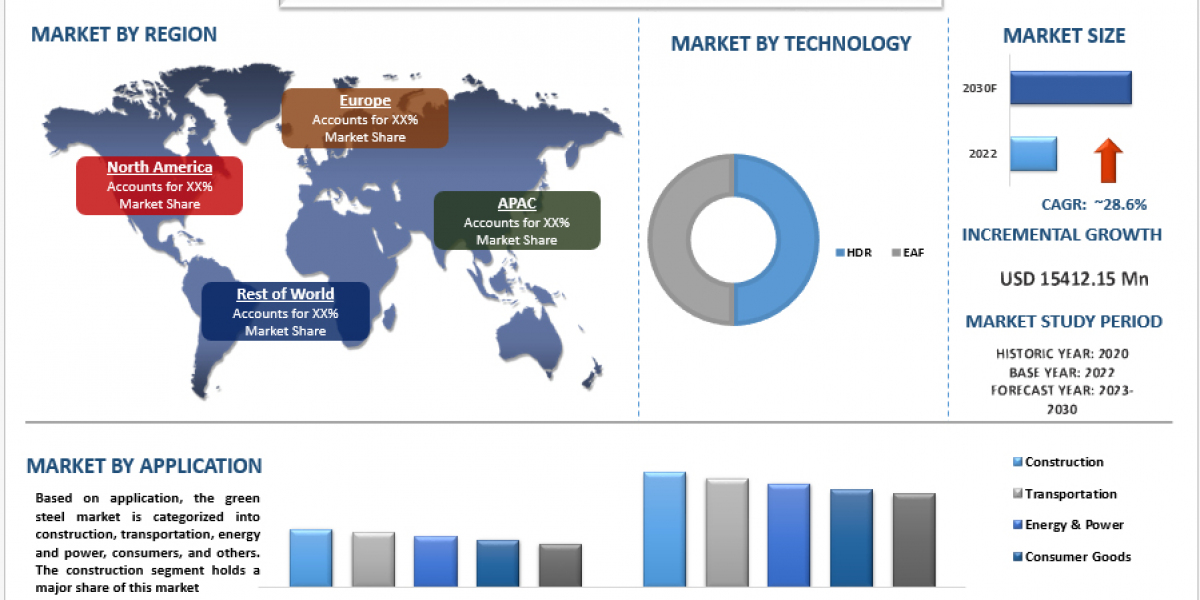According to a new report by UnivDatos Market Insights, the Green Steel Market is expected to reach USD 15412.5 Million in 2030 by growing at a CAGR of 28.6%. The global steel industry has experienced significant growth and development in recent years with an increasing focus on environmental sustainability and reducing carbon emissions. Governments and regulatory bodies around the world have introduced strict environmental regulations to limit greenhouse gas emissions and promote clean energy solutions, which has led to the adoption of greener technologies and practices in the steel industry. In developed countries like the United States, Canada, and Europe, there is a growing emphasis on sustainable construction and infrastructure projects. Green building certifications and regulations prioritize the use of environmentally friendly materials, including low-carbon steel. This has created a favorable market for green steel products in these regions.
Request To Download Sample of This Strategic Report - https://univdatos.com/get-a-free-sample-form-php/?product_id=53009
What does future green steel production Require the Most?
To achieve a carbon-free transition towards green steel, the energy industry should prioritize the production of green hydrogen using electrolysis. Unlike other methods which require the burning of natural gas to release hydrogen, electrolysis involves splitting water (H2O) into oxygen and hydrogen by utilizing renewable energy sources. In achieving full green steel production, the process will require the use of green hydrogen, electrolyzers that run on renewables, as well as additional renewables for all parts of the supply chain.
Emerging economies in Asia, such as China and India, are also experiencing growth in the demand for green steel. As they continue to rapidly industrialize and urbanize, their governments are pushing for the adoption of cleaner technologies and encouraging steel manufacturers to reduce their carbon emissions. This has resulted in significant growth in the market for green steel in Asia.
Sweden Has a Strong Presence Of Green Steel
Sweden has been leading the way in sustainability initiatives and has set ambitious goals to reduce carbon emissions. The country aims to achieve carbon neutrality by 2045 and is promoting the development and adoption of green technologies across various industries, including steel production. One such initiative is the HYBRIT project, a joint venture between Swedish steel manufacturer SSAB, iron ore producer LKAB, and energy company Vattenfall. The project aims to replace traditional coal and coke used in steelmaking with hydrogen produced using renewable energy sources. This innovative approach is expected to achieve net-zero carbon emissions in the steel production process and has gained international attention and support, making Sweden a global pioneer in green steel production.
Apart from the HYBRIT project, other Swedish steel companies have also made significant progress in reducing their carbon footprint. Höganäs AB, a leading global manufacturer of metal powders, has implemented several measures to improve energy efficiency, reduce waste, and minimize emissions. They have invested in renewable energy sources and innovative technologies to mitigate their environmental impact.
Ask for Report Customization - https://univdatos.com/get-a-free-sample-form-php/?product_id=53009
Browse Related Reports:
· Carbon Offset and Carbon Credit Trading Service Market
· Middle East Solid State Transformer Market
· India Gas Insulated Switchgear Market
· Wind Turbine Pitch System Market
Conclusion:
European steel manufacturers are at the forefront of producing sustainable steel due to a combination of strict environmental regulations, growing market demand for eco-friendly products, government funding for research and development, industry-wide collaboration, and long-term investment strategies. These factors have created a culture of innovation and sustainability, making European steel companies pioneers in the worldwide shift towards greener industrial practices.









